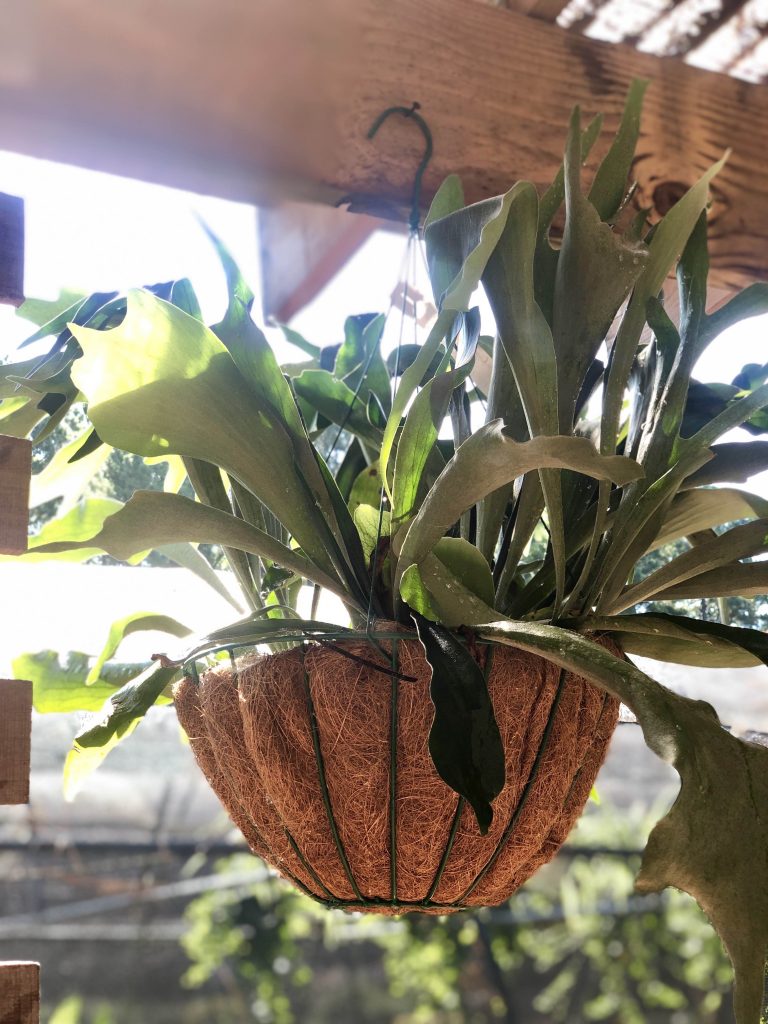How to Grow Staghorn Ferns

Always wanted to learn how to grow Staghorn ferns? We have been growing them for a long time; here are our carefully cultivated tips!
What is a Staghorn Fern?
There are over 12,000 species of ferns, which are one of the most ancient plants known. Staghorn ferns used to be pretty difficult to find but as they have grown in popularity, they are much more readily available.
Fiddleleaf Figs, Snakeplant or Mother-in-Law’s Tongue and of course, Monstera are very trendy now too. Each one has its own unique characteristics but one thing they all have in common is big leaves, which provide bold texture. Check out those elongated, forked fronds (which is what fern leaves are called) that look like antlers… that is how this fun fern got its name. Those fronds are actually called antler fronds. Staghorn ferns are epiphytes, plants that grows on other plants or structures for support. Epiphytes are not parasitic; they get moisture and nutrients from the air, rain, water and debris accumulating around them. And yes, this is the plant often mounted onto a wooden plank with moss or burlap, a popular growing trend.
Staghorn ferns also grow well in hanging baskets such as the one pictured above. The rounded, plate-like fronds are shield fronds that eventually dry and protect the plant roots. If you have visited our hothouse in the cool season, or the pavilion in the warm season, you might have noticed a huge Staghorn fern hanging around. This plant is now 15 years old, and the shield fronds have completely enveloped the original hanging basket it was planted in.
When growing Staghorn ferns on wooden plaques, avoid remounting the plants. Instead, as the shield fronds creep towards the outside edges of the plaque, mound the original plaque onto a larger one, without disturbing the fronds or roots.
Proper watering for Staghorn ferns
The roots primarily function to keep the plant secured in place. The fronds and the roots both absorb water. This is important to remember when choosing a planting container and soil; drainage is key. Applying too much water to the root system could result in root rot. Because every growing situation is different, we cannot specify a watering schedule but a good rule of thumb would be to mist often, and water once a week in the warm season, once every few weeks in the cool season. Modify this schedule for your particular growing situation as needed. Reduce watering and misting when the ferns are in humid environments.
If antler fronds turn brown or black at the base, the plant may be getting too much water. If fronds are turning brown on the tips and wilting, they may not be getting enough water. Keep in mind that the shield fronds will turn brown naturally as they age, and the undersides of the antler fronds often have naturally occurring brown spores. Neither is a reason for concern. A Moisture Meter might be helpful as a training tool, until you get used to a watering schedule for your fern. Learn more about Moisture Meters here.
Lighting for Staghorn ferns
Staghorn ferns are easy to grow; they like bright, indirect light and good drainage. Avoid placing them in direct sun. These ferns grow well in shady spots outdoors during the warm season. When temperatures start dipping below 60 degrees, bring them indoors for the cool season. They will be fine down to around 50 degrees but since forecasts can vary, we suggest bringing them in around 60 degrees to be safe.
Feeding your Staghorn fern
Young ferns benefit from regular fertilizer. During the warm growing season, fertilize with a water soluble, balanced fertilizer each month. Liquid Seaweed is always a good fertilizer for ferns. Staghorn ferns do not grow as much during the cool season, fall and winter; reduce fertilizing to every 8 weeks during this time. Mature plants grow just fine with only twice a year feedings.
Where to buy Staghorn ferns
Right here at The Good Earth! We typically have them in a variety of sizes, from tiny terrarium size plants, all the way up to 14″ hanging baskets. The smaller sizes, 2-6″ pots, work well for mounting on wood, while the hanging baskets are ready to hang and enjoy!